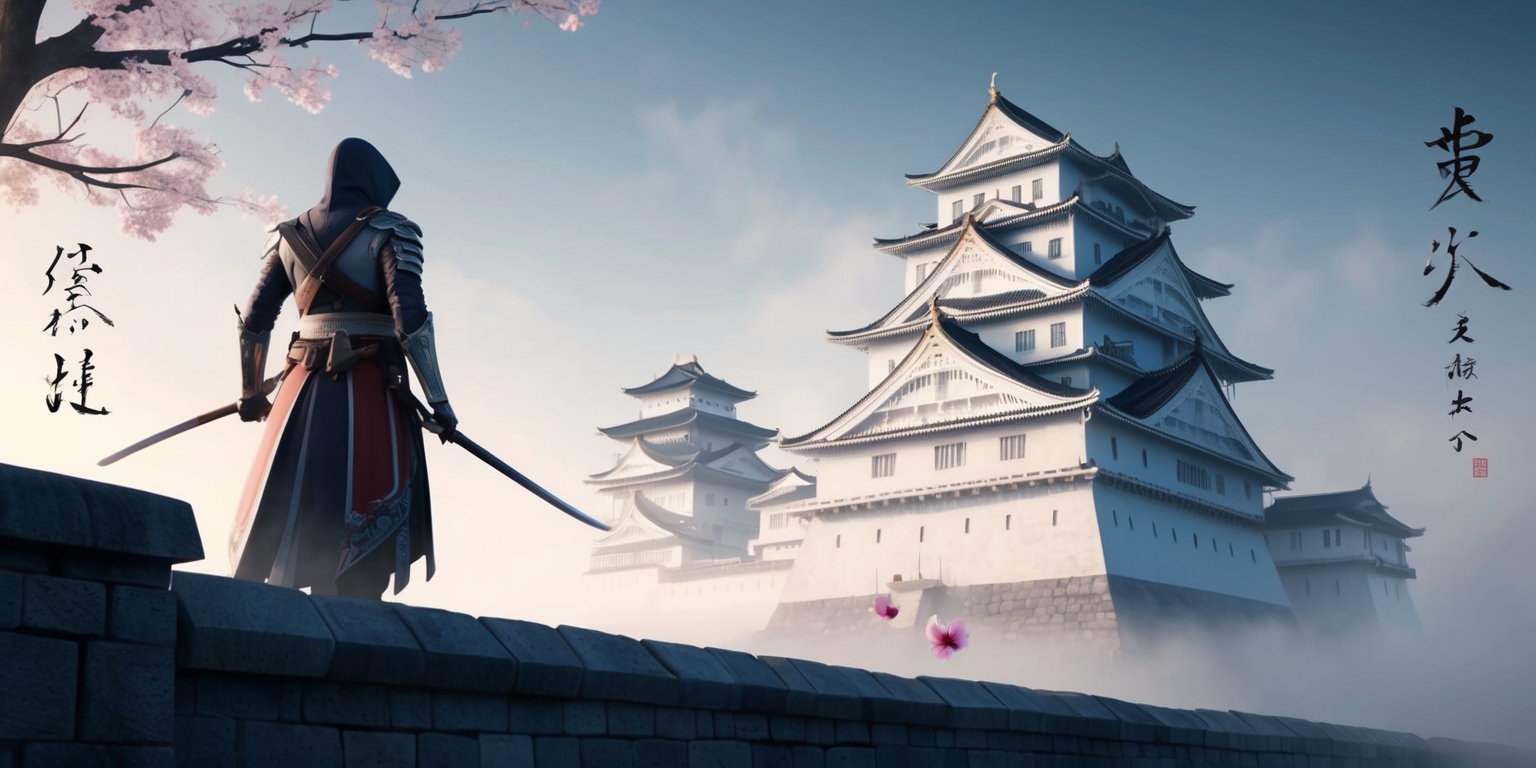Mastering Himeji Castle: The Tactical Artistry of Assassin's Creed Shadows
Apr-21-2025

Assassin's Creed Shadows offers a multifaceted adventure steeped in historical ambiance and strategic gameplay. While traversing the storied corridors of Himeji Castle, players are encouraged to dive headfirst into an entirely new realm of challenge, stealth, and tactical precision. Every corner of the fortress presents opportunities for careful planning and swift execution, ensuring that every mission is as unpredictable as it is rewarding. The intricate design of the castle, filled with samurai adversaries and hidden alarms, calls for a mindful approach where each choice directly impacts the overall success of the mission. Navigating through such rich landscapes requires an understanding of the castle’s layout, strategies tailored to both stealth and force, and the adaptability to handle unexpected encounters.
Historical Atmosphere and In-Game Realism
The depiction of Himeji Castle in Assassin's Creed Shadows brings historical accuracy into sharp focus, offering players a chance to appreciate the architectural marvels of the period. The game designers have meticulously recreated the castle grounds, ensuring that each building, tower, and walkway resonates with the flavor of old Japan. The realistic textures and environmental details not only elevate the visual experience but also contribute to an immersive gameplay that feels authentic and engaging. Players can explore hidden corridors and observe the careful placements of enemy alarms that serve as reminders of the castle’s defensive strategies. This authenticity extends to the behavior of the castle's guardians, whose patterns are designed to mirror historical practices. The result is a journey that feels both artful and meticulously planned.
Tactical Approaches to Disabling Security Measures
Among the most captivating facets of the… Himeji Castle mission in Assassin's Creed Shadows centers on neutralizing security measures. The castle is fitted with strategic alarms that, if left active, can alert the entire fortress to any suspicious activities. Players are encouraged to employ stealth tactics by carefully sabotaging these devices before progressing deeper into enemy territory. A well-timed throw of a kunai or shuriken can disarm crucial components of the alarm system, effectively preventing an overwhelming enemy response. Moreover, ascending to elevated positions and using the in-game sabotage prompt adds another An extra strategic element, as players are compelled to adjust their… approach according to the situation. This element of the game forces players to balance aggression with caution and ensures that every step is meticulously planned, heightening the satisfaction of a well-executed mission.
Mastering Combat and Character Versatility
Engaging with the enemy samurai demands both precision and adaptability. Throughout Himeji Castle, players encounter several key adversaries whose defeat is pivotal for unlocking vital rewards. In these encounters, the gameplay emphasizes the importance of both stealth and head-on confrontation. Switching characters strategically, particularly using the strengths of Yasuke, allows for dynamic responses to different combat scenarios. The game presents situations where the player might need to rely on the silently orchestrated assassinations of Naoe, or switch to more aggressive tactics with Yasuke to overcome challenging battles. This fluidity in combat styles Infuses gameplay with an added level of sophistication, urging players to be adept at revising tactics on the fly, and ensuring that no two encounters become monotonous.
Exploration and Navigation of Intricate Castle Grounds

Walking the grounds of Himeji Castle is an experience defined by exploration and attention to detail. Every pathway and hidden corner of the castle hints at the tactical layout envisioned by its creators. Players must be mindful of potential hazards, such as enemy placements and environmental triggers, as they seek to locate the five critical samurai adversaries. The game rewards thorough exploration by encouraging players to identify key landmarks that provide hints of concealed enemy positions or hidden alarms. This level of detail pushes players to take their time, learning the intricacies of the castle layout, and appreciating the diversity of its design. The strategic use of observation skills to monitor enemy movements and locate vital control points invites a rewarding immersion in a rich, historically inspired virtual environment.
Balancing Stealth and Strategic Aggression
The delicate balance between maintaining stealth and applying strategic aggression is central to progressing through Himeji Castle. The gameplay design subtly challenges players to quickly decide when to remain undetected or when to engage in more forceful combat. Throughout the castle, various situations demand complete discretion; for instance, approaching an unsuspecting samurai from behind can secure a swift and discreet elimination. Conversely, certain areas with multiple adversaries may call for a more robust, direct approach that capitalizes on overwhelming strength. Players must evaluate the situation dynamically, ensuring that their chosen method of attack is both efficient and aligned with their character’s strengths. This interplay of stealth and aggression adds a captivating tension, driving a sense of urgency that underscores each decision made within the castle walls.
Evaluative Use of In-Game Resources and Abilities
As players progress through Himeji Castle, resource management becomes a critical component of success. The game encourages the effective use of specialized equipment and character-specific abilities to overcome challenges. For instance, knowledge of how to disable alarms without raising an immediate threat is essential when navigating crowded rooms. Likewise, leveraging unique combat skills such as the Observation tool offers players a tactical advantage by highlighting critical enemy positions and landmarks within the fortress. Balancing these resources while dealing with the escalating difficulty of encounters requires a careful approach that is both methodical and adaptive. Each decision to employ a specific tool or ability can significantly influence the ease with which players navigate through the game, providing a substantial incentive to master the available strategies.
Dynamic Environmental Interactions and Player Agency
The continuously evolving interplay between the player and the environment environment offer a deeper layer of engagement within Himeji Castle. The castle is designed to feel alive, with interactive elements that can be utilized to gain tactical advantages. For example, barrels strategically placed near enemy patrols can be used to create distractions, demonstrating how even ordinary objects in the game world become pivotal to achieving objectives. The player is granted unrestricted freedom to roam and discover these interactions, transforming seemingly minor elements into opportunities for safe passage. The interplay between the environment and tactical decisions further stresses the necessity for careful planning and observation. This degree of environmental agency elevates the experience from simply following a preset path to actively engaging and manipulating the surroundings in clever and resourceful ways.
Precision in Target Identification and Execution
Critical to advancing in Himeji Castle is the precise identification and execution of objectives, particularly in targeting the key samurai. Each adversary is positioned in a unique setting that offers both challenges and opportunities for tactical maneuvers. The game encourages players to meticulously scout the environment, using Observation and other sensory tools to pinpoint the locations of these warriors. Parameters such as lighting, line-of-sight, and spatial layout play significant roles in formulating an effective approach. In scenarios where multiple pathways present themselves, the careful selection of the optimal route can They serve as the decisive factor that separates a successful mission from an unsuccessful outcome sprawling confrontation. This focus on precision fosters a gameplay style that emphasizes foresight, calculated movement, and an in-depth understanding of the castle's combat flow.
Utilizing Character Strengths for Varied Situations
Handing over control between characters is not only a narrative device but a strategic mechanic essential to conquering Himeji Castle. Each character brings a distinct set of strengths that can be adapted to different circumstances encountered throughout the fortress. For example, while one character might excel in stealth transitions, another might be better suited for occupancy of heavily guarded sections. This flexibility permits players to creatively approach challenges, delegating tasks such as swiftly clearing corridors or methodically bypassing full watchful patrols. The opportunity to switch characters based on real-time demands reinforces the need for situational awareness and underscores the subtle interplay of each character's abilities. Such a system ensures that every engagement is fresh, reinforcing the notion that adaptability is as valuable as skill in this immersive tactical experience.
Engaging Challenges and Immersive Combat Scenarios
Combat scenarios in Himeji Castle are meticulously designed to provide a blend of suspense and tactical depth. Each section of the castle introduces unique challenges where adversaries operate under distinct conditions, ranging from isolated patrols on elevated platforms to coordinated groups near key architectural features. The design encourages players to analyze enemy patterns, making use of ambient cover and exploiting the castle's layout to gain the upper hand. The layered difficulty of combat not only tests a player's proficiency with both stealth and strategic assaults but also reinforces the importance of timing and animal instincts in high-pressure encounters. Such immersive combat scenarios demand a keen sense of observation and swift adaptability, creating a rich, engaging experience that rewards both patience and decisiveness throughout every encounter.
Reward Mechanics and Unlockable Game Enhancements
After successfully navigating the intricate and perilous challenges of Himeji Castle, players are rewarded with significant Refinements that elevate every dimension of the gaming journey. The unlocking of a legendary chest is a testament to the player's dedication to mastering every facet of the castle's defenses. Behind this treasure lies a collection of valuable upgrades, including specialized gear enhancements and mastery points that not only improve physical combat proficiency but also offer long-term benefits on subsequent missions. The reward system in Assassin's Creed Shadows is intricately tied to the challenges faced, ensuring that every precise maneuver and tactical choice culminates in a tangible boost to the player's progress. Such enhancements serve as powerful incentives, fueling further exploration and encouraging mastery over the evolving battlefield dynamics without diminishing the inherent thrill of each objective.








